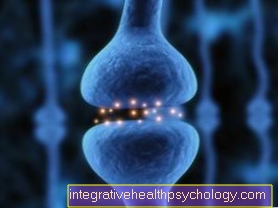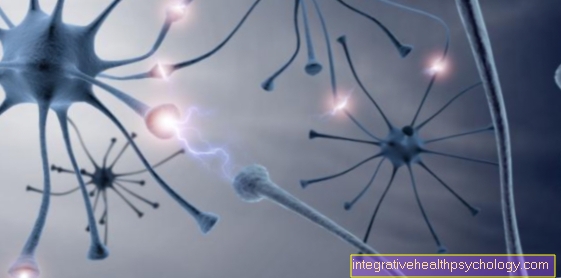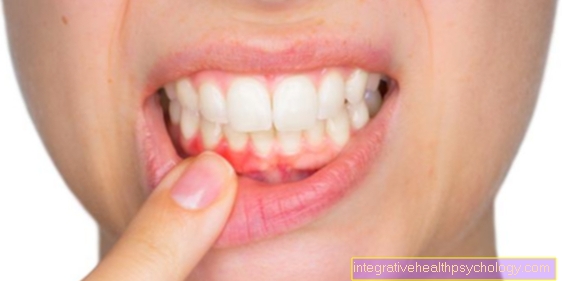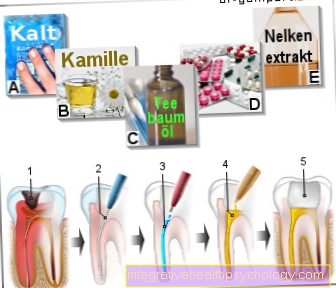Paracetamol while breastfeeding
Introduction - Is Paracetamol Allowed During Breastfeeding?
Paracetamol is allowed as a pain reliever and antipyretic drug during breastfeeding. However, the active ingredient should not be taken over a long period of time or in higher doses. You should also be careful when combining it with other drugs.
Since, in principle, no randomized studies may be carried out on breastfeeding women, all findings on the safety of paracetamol are based solely on the evaluation of clinical experience. It has been shown that paracetamol is found in small amounts in breast milk after a nursing mother has taken it.
Adverse effects or side effects during breastfeeding are not yet known. Paracetamol can be taken during pregnancy and breastfeeding after weighing the risk-benefit ratio.
Read more on the topic: Painkillers while breastfeeding

Active ingredient, effect
Paracetamol is also chemically 4-hydroxyacetanilide, Acetaminophen or Paracetamoium called. The drug paracetamol is very effective for mild to moderate pain and fever.
That is why it is used for:
- Colds
- sniff
- Sinus infection
- a headache
- migraine
- Menstrual pain
- Toothache
and many more.
Different to Acetylsalicylic acid (ASS) Paracetamol is also suitable for infants and children with fever and pain. Paracetamol belongs to the group of active ingredients known as non-opioid pain relievers, including non-acidic antipyretic agents. The active ingredient inhibits an enzyme Cycloocygenase-2 (COX-2) called. This enzyme controls the formation of the body's own messenger substances, the prostaglandins. Prostaglandins are released by the body when there is inflammation and then cause classic signs of inflammation such as swelling, redness, warmth and pain. Prostaglandins also irritate the nerve endings and are involved in the transmission and perception of pain in the brain. Paracetamol suppresses by inhibiting the enzyme COX-2 the formation of prostaglandins and ultimately less pain is perceived in the brain.
Paracetamol also has an effect on other messenger substances; more serotonin is released in the spinal cord, which also inhibits the transmission of pain to the brain.
Paracetamol is also said to influence pain perception in the brain itself by changing receptors for messenger substances such as glutamate-NMDA and nitric oxide. Through this mode of action, paracetamol effectively leads to pain relief.
It also has a strong fever-lowering effect, as it influences temperature regulation in the brain.
You might also be interested in: Pain while breastfeeding
Side effects
Paracetamol can cause side effects, but not everyone gets them. Everyone reacts differently to medication. Paracetamol rarely leads to a change in blood values, which means that in rare cases a rise in liver enzymes can be found in the laboratory.
Very rarely, other laboratory changes such as a lack of platelets, a lack of white blood cells, a lack of certain white blood cells (den Granulocytes) or even a lack of all blood cells.
Serious skin reactions such as Stevens-Johnsons Syndrome, a toxic epidermal, can occur very rarely Necrolysis or an acute, generalized pimple rash.
Hypersensitivity reactions can occur as side effects with any drug, including: simple reddening of the skin to hives, larynx swelling, shortness of breath, sweating, nausea, drop in blood pressure and allergic shock.
Treatment must be discontinued in the event of such severe side effects.
In particularly sensitive people, bronchial cramps can develop, in the so-called analgesic asthma, which is caused by painkillers. It is important that an overdose of paracetamol can cause severe liver damage. With long-term use and higher doses, paracetamol can cause headaches, tiredness and nervousness. If the drug is taken for a long time and suddenly stopped, muscle pain can be caused.
Interactions
If you take acetaminophen at the same time as the gout drug Probenecid a, the excretion of paracetamol is reduced, so it works longer. In this case the dose of paracetamol should be reduced.
Taking the anti-inflammatory drug salicylamide when taken with paracetamol may cause paracetamol to stay in the body longer and to build up.
Some sleeping pills and anti-epileptic drugs, like Phenobarbital, phenytoin, carbamazepine and Rifampicin, as well as alcohol promote the breakdown of paracetamol into a toxic metabolic product. This means that paracetamol in combination with the mentioned agents can become toxic to the liver even in low doses.
If paracetamol is taken for more than a week, it increases the effects of blood thinners (Anticoagulants). Occasional use of paracetamol, on the other hand, has no effect on blood thinning.
Taking paracetamol and the AIDS drug Zidovudine sometimes leads to the development of a deficiency in certain white blood cells neutrophil granulocytes. Therefore, paracetamol should only be taken in combination with this active ingredient after medical advice. The drug Colesryramine (Therapy of lipid metabolism disorders) reduces the absorption of paracetamol in the body and its effects.
Contraindications
Paracetamol must not be taken if there is hypersensitivity to paracetamol and chemical relatives of the substance (Acetaminophen Derivatives). In the case of severe damage to the liver cells, ingestion should be avoided.
Paracetamol may only be used for liver dysfunction, chronic alcohol abuse, severe kidney dysfunction and Gilbert-Meulengracht disease after a careful risk-benefit assessment by the doctor. In these cases, the intake must be checked by a doctor.
Dosage during breastfeeding
During breastfeeding, the active ingredient paracetamol should not be taken over a long period of time and in higher doses or combinations with other agents. For adults, the maximum daily dose is 4,000 milligrams of paracetamol. That corresponds to eight tablets of 500 milligrams paracetamol each.
It has been proven that the active ingredient passes into breast milk during breastfeeding and that small amounts can be absorbed by the baby. There are observations that have come to the conclusion that paracetamol is to be regarded as safe for the child within the recommended dose amount. Nonetheless, you should dose paracetamol as low as possible during breastfeeding and use it for as short a period of time as possible. The maximum dose must not be exceeded.
You might also be interested in: Medication during breastfeeding
Paracetamol Or Ibuprofen, Which Is Better?
Paracetamol is the pain reliever of choice during pregnancy and breastfeeding. It effectively helps with mild to moderate pain and has an antipyretic effect. So far there are no noteworthy indications of intolerance on the part of the infant. Paracetamol should not be taken if there are allergies to the active ingredient, liver damage or other contraindications. In such a case, you can fall back on ibuprofen.
You may also be interested in this article: Ibuprofen when breastfeeding
For toothache, however, ibuprofen is usually more helpful than paracetamol, as it also has an anti-inflammatory effect. Ibuprofen may be taken for toothache while breastfeeding.
Read more on the topic: Problems during breastfeeding in children
Paracetamol for headaches while breastfeeding
Paracetamol is generally considered a well-tolerated drug and is often used to treat headaches. Children, pregnant and breastfeeding women are also allowed to take the product. In the event of a headache, the maximum daily dose of 4,000 milligrams of paracetamol must not be exceeded. There should be six to eight hours between intake.
Side effects are very rare and overdosing must be avoided. Paracetamol works well for headache and migraine relief. You shouldn't take the headache pills for more than three days at a time.
Paracetamol is less suitable for "hangover" headaches, as the active ingredient is broken down in the liver just like alcohol and the liver is stressed by the additional consumption and the simultaneous breakdown of alcohol.
Read more on the topic: Problems during breastfeeding for the mother
Paracetamol for toothache while breastfeeding
Paracetamol is less suitable for toothache than other pain relievers like ibuprofen and aspirin. Paracetamol has a pain-relieving and effective antipyretic effect. Agents like ibuprofen or aspirin have an anti-inflammatory effect in addition to their pain-relieving component.
Toothache is often inflammatory, so it makes sense to choose a pain medication that is both pain-relieving and anti-inflammatory. For women who are breastfeeding, ibuprofen is the drug of choice for toothache.
You might also be interested in: Paracetamol for toothache? Only suitable to a limited extent!

















.jpg)











